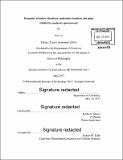Dynamics of lattice vibrations, molecular rotations and spins studied by terahertz spectroscopy
Author(s)
Lu, Jian, Ph. D. Massachusetts Institute of Technology
DownloadFull printable version (39.93Mb)
Other Contributors
Massachusetts Institute of Technology. Department of Chemistry.
Advisor
Keith A. Nelson.
Terms of use
Metadata
Show full item recordAbstract
In this thesis, I describe generation of strong THz electromagnetic pulses with broad bandwidths or tailored waveforms using organic nonlinear optical crystals and spectroscopy experiments utilizing THz pulses to study the linear and nonlinear responses of molecular dipole, spin, and lattice degrees of freedom in molecular and condensed-matter systems. We have developed several THz spectroscopy methods suitable for interrogating different material systems including THz pump-optical probe spectroscopy, THz time-domain electron paramagnetic resonance (EPR) spectroscopy, and twodimensional (2D) THz spectroscopy using either the THz electric or magnetic field. Using the electric fields of two time-delayed strong THz pulses, we have demonstrated 2D THz rotational spectroscopy. In the time domain, we have directly observed THz photon echoes and other nonlinear dynamics originating from the rotating permanent dipoles of a thermal ensemble of gas-phase molecules. Multiple pathways that lead to the nonlinear responses are mapped out in the 2D THz rotational spectrum, which allows the detailed study of the nonlinear THz field-dipole interactions with resolution of each rotational level. We have demonstrated a new THz EPR technique that allows rapid and precise determination of the THz-frequency spin energy level structures characteristic of molecular complexes including molecular magnets and metalloproteins which contain high-spin transition-metal ions. The linear THz spectra of several molecular complexes both in the absence of and as a function of an external static magnetic field show the absorption features and their magnetic field-dependence as expected from quantum mechanical simulations, which allow precise determination of the spin energy level structures. We have demonstrated 2D THz magnetic resonance spectroscopy and its application to directly reveal the nonlinear dynamics of collective spin waves in a magnetic material. The 2D THz spectra reveal spin echoes that have the highest frequency ever observed, and correlations between the spins. In a bulk quantum paraelectric material, we have observed temperature-dependent lattice dynamics and fluctuating polar domain dynamics, both associated with the incipient ferroelectric structural phase transition, through time-resolved optical second harmonic generation. We have observed that THz fields break lattice centrosymmetry in a paraelectric material, which results in THz activity in originally only Raman-active vibrational modes. The THz pulse can provide a second interaction that leads to the excitation of coherent Raman-active vibrations, which are detected by Raman scattering through optical birefringence.
Description
Thesis: Ph. D., Massachusetts Institute of Technology, Department of Chemistry, 2017. Cataloged from PDF version of thesis. Includes bibliographical references.
Date issued
2017Department
Massachusetts Institute of Technology. Department of ChemistryPublisher
Massachusetts Institute of Technology
Keywords
Chemistry.